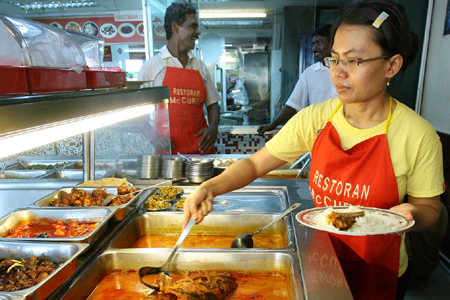Photos
Currying favor with the Chinese
Updated: 2011-01-17 11:19
(China Daily)
|
 |
|
An employee serves curry dishes at an Indian restaurant. As the population from Arabic regions increases fast in China, Indian restaurants are seeing a large demand for curry across the country. [Photo / Bloomberg] |
BEIJING - By importing Indian food and opening more restaurants, the Zhuhai-based India Kitchen group is building a spices kingdom in China with an annual sales revenue beyond $10 million.
"As the population from Arabic regions increases fast in China, we are seeing a large demand in curry food, in which we have specialized for more than 20 years," said Roberto Gnanabelu, sales manager of Indian Kitchen Management Co Ltd. "We are going to open one or two new restaurants and a franchised store selling spices this year in Beijing."
The business has grown from a small restaurant providing Indian cuisine for international tourists in 1985 in Macao, where the company founder, known simply as M. Antony, first stayed after he came to China from Chettinad, South India. It now incorporates importing and Anthony has his own factories producing fast curry sauce in Zhongshan and Zhuhai, Guangdong province, for which he is seeking an export license as a local food manufacturer.
The fast curry sauce, of which it is said "even a blind man can cook", is designed for Chinese households who are not good at preparing complicated curry cuisine. Simply boiling with rice is sufficient. "It's very like Lee Kum Kee's XO sauce," Gnanabelu said, referring to the 122-year-old Chinese traditional soybean sauce.
According to the company's website, it currently imports several brands of snacks, pickles, mango pulp, tea powder and Basmati rice from India, including Haldiram's Snacks, Mother's Pickle, Everest Masala, Kohinoor, Lalquila Basmati Rice, Pillsbury Atta (wheat flour) and Taj and Red Label tea.
"We are the only legal importer of these Indian brands in China," Gnanabelu said, adding that a large amount of Indian food products are smuggled through Hong Kong and Shenzhen. "Hotels cannot purchase the smuggled food. We have a partner in Beijing called Jingguangjia Trading Group that helps us sell goods to clients, such as the Hilton hotels."
Building on the reputations of its 18 chain restaurants in major cities including Beijing, Shanghai, Hangzhou and Qingdao, the company has developed a distribution network all over China.
According to Gnanabelu, India Kitchen presently is well developed in Guangdong and nearby regions. People can find its products in big supermarkets there, such as Metro, PARKnSHOP and 1jia1. Some of its star products are also selling in Beijing's well-known imported-food supermarkets, including the friendship supermarket and Jenny Lou's, near the city's embassy district.
As the biggest Indian spices trader in China, India Kitchen also hires Chinese natives from factory workers to executives. Indian chefs and Chinese waiters work alongside each other at its Beijing restaurant located next to a tranquil riverbank near Sanlitun.
| ||||
"We switched our business from only doing restaurants to trade and manufacture in 1990," Gnanabelu, who also has the Chinese name An Dawei, said.
"We also see a huge market in other countries in Asia, such as Japan, South Korea, and the Southeast Asia countries," he added. To produce the spices these markets need, India Kitchen's Guangdong manufacturing base is undergoing the process of China's exporting standard evaluations for food.
Trade between India and China in the first 10 months of 2010 grew by 58 percent, data from the Confederation of India Industry (CII) shows. "Processed and unprocessed food is among the seven sectors with most growth potential for investment in the future," said E.B. Rajesh, the chief representative of CII in China. The other six industries include IT, pharmaceuticals and auto components, which have been recognized as India's signature industries.
Specials

President Hu visits the US
President Hu Jintao is on a state visit to the US from Jan 18 to 21.

Ancient life
The discovery of the fossile of a female pterosaur nicknamed as Mrs T and her un-laid egg are shedding new light on ancient mysteries.

Economic Figures
China's GDP growth jumped 10.3 percent year-on-year in 2010, boosted by a faster-than-expected 9.8 percent expansion in the fourth quarter.


